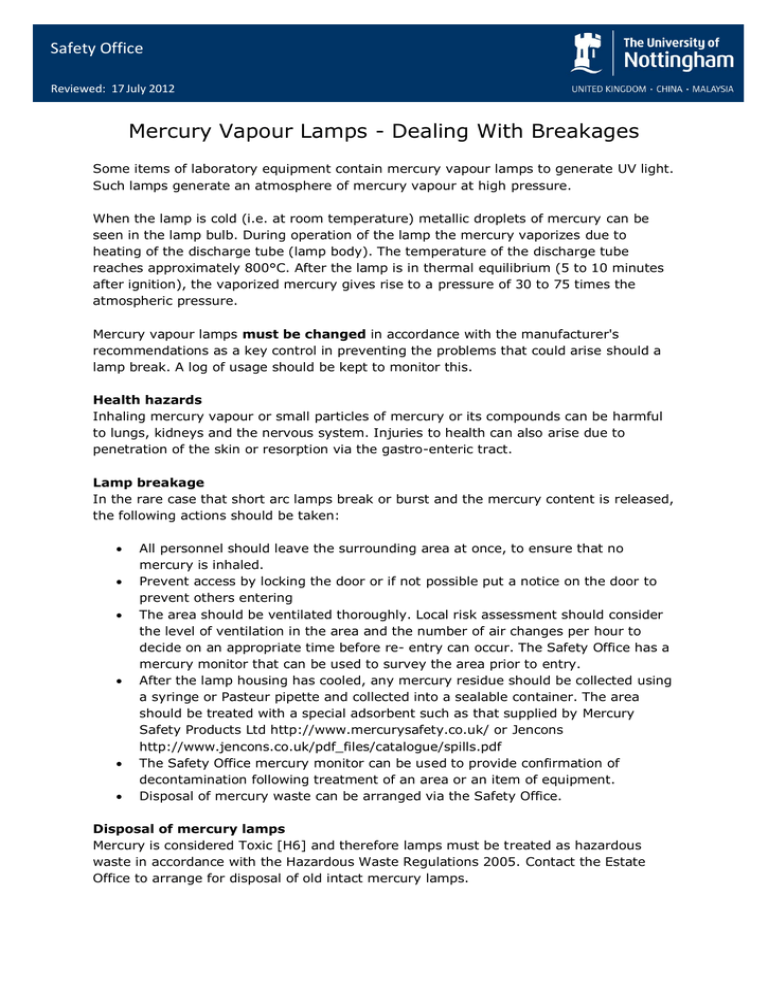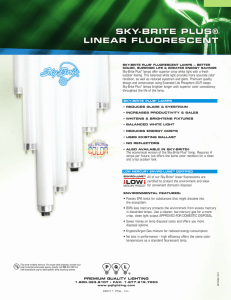Mercury Vapour Lamps - Dealing With Breakages
advertisement

Safety Office Reviewed: 17 July 2012 Reviewed: DD Month Year Mercury Vapour Lamps - Dealing With Breakages Some items of laboratory equipment contain mercury vapour lamps to generate UV light. Such lamps generate an atmosphere of mercury vapour at high pressure. When the lamp is cold (i.e. at room temperature) metallic droplets of mercury can be seen in the lamp bulb. During operation of the lamp the mercury vaporizes due to heating of the discharge tube (lamp body). The temperature of the discharge tube reaches approximately 800°C. After the lamp is in thermal equilibrium (5 to 10 minutes after ignition), the vaporized mercury gives rise to a pressure of 30 to 75 times the atmospheric pressure. Mercury vapour lamps must be changed in accordance with the manufacturer's recommendations as a key control in preventing the problems that could arise should a lamp break. A log of usage should be kept to monitor this. Health hazards Inhaling mercury vapour or small particles of mercury or its compounds can be harmful to lungs, kidneys and the nervous system. Injuries to health can also arise due to penetration of the skin or resorption via the gastro-enteric tract. Lamp breakage In the rare case that short arc lamps break or burst and the mercury content is released, the following actions should be taken: All personnel should leave the surrounding area at once, to ensure that no mercury is inhaled. Prevent access by locking the door or if not possible put a notice on the door to prevent others entering The area should be ventilated thoroughly. Local risk assessment should consider the level of ventilation in the area and the number of air changes per hour to decide on an appropriate time before re- entry can occur. The Safety Office has a mercury monitor that can be used to survey the area prior to entry. After the lamp housing has cooled, any mercury residue should be collected using a syringe or Pasteur pipette and collected into a sealable container. The area should be treated with a special adsorbent such as that supplied by Mercury Safety Products Ltd http://www.mercurysafety.co.uk/ or Jencons http://www.jencons.co.uk/pdf_files/catalogue/spills.pdf The Safety Office mercury monitor can be used to provide confirmation of decontamination following treatment of an area or an item of equipment. Disposal of mercury waste can be arranged via the Safety Office. Disposal of mercury lamps Mercury is considered Toxic [H6] and therefore lamps must be treated as hazardous waste in accordance with the Hazardous Waste Regulations 2005. Contact the Estate Office to arrange for disposal of old intact mercury lamps.






